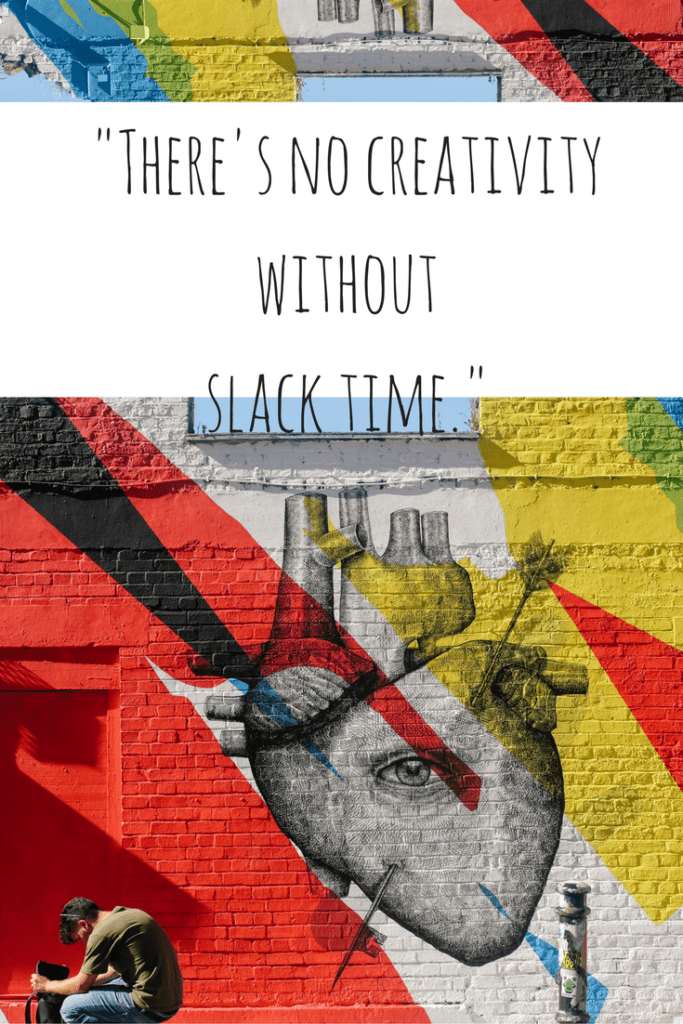Procrastination part 2: There’s No Creativity Without Slack Time
( audio recording at the bottom)
” There’s no creativity without some slack time. “
I’d purchased a groupon for 30 days of yoga classes, I’d never done yoga before, but I exercised, and figured this might be a fun change. With determination to take full advantage of my 30 days pass, I decided that I was going to take a class every day. The first few classes went smoothly, raising my confidence level, allowing me to simply select the class that best fit my schedule, ignoring the description.
It was my 4th yoga class ever, I walked through the door, feeling fine, and then I started to see the other people walk through the door. They had muscles, like big, muscles, signaling that I just might be in over my head. Then as we set on our mats, the instructor asked what people wanted to work on, and I heard people saying inversions. As I sat quickly in the back corner ( I was so thankful to be in that corner), I was thinking, inversions, like up-side-down, what are these people talking about.
For the remainder of the class, I stayed in my little corner, doing some downward dogs and child’s pose, and pulling my jaw up off of the floor as people sprung from crow to a handstand, and then smoothly back into crow ending stretching out in plank. If these words mean nothing to you, then basically know that I was watching people levitate all around me, and I wasn’t about to try.
When the gap in knowledge is too big, we become afraid ( sometimes rightly so), and we don’t try.
In the above situation, fear was keeping me from cracking my head open. I’d blindly walked into the most advanced yoga class offered, and there was just too much that I didn’t know, so I stayed hidden and quite in the back corner, hoping that no one would notice me.
What if your student’s procrastination is the result of fear?
As a teacher your job is to challenge your students, to present them with new information, and to make them curious, by creating a gap between what they already know and what they could know. But when the gap is too big, they stop being curious and start being afraid. Some students will be willing to ask questions, while for others the gap will be so big, that they fear they don’t even know enough to ask a good question, launching them into what looks like procrastination. In part 1 we renamed procrastination as incubation, giving it a positive light. Today we’re going to rename procrastination, fear.
” I learned that courage was not the absence of fear, but the triumph over it…. The brave man is not he who does not feel afraid, but he who conquers that fear. ” Nelson Mandela
If a student isn’t moving forward, how can you make the gap smaller?
Often when it seems like a student is procrastinating, as teachers, we get frustrated, angry, and tell them to get to work, or simply ask them if they have any questions. When a student isn’t moving forward, it’s your job to ask the questions. If you’ve given your students the assignment to write an artist statement and they just sit there staring at the blank page, watch what happens if you start to ask them questions.
What kind of art do you enjoy looking at?
Do you like bright or dull colors?
What’s your favorite way to create art, ie; painting, pencil drawing, photography, or digital art?
Through your questions, you’re breaking the seemingly daunting task of writing an artist statement down into something much easier.
Have you given the students enough boundaries?
There was a study done where they took a group of students to a park, set them lose, and told them to go and play. While the students moved some, for the most part, they stayed close to one another in the middle of the park. The same group of students was then taken to a second park, given the same instructions, and off they went, playing and spreading out.
What was the difference?
Park number 2 had a fence, giving the students borders, making them feel safer, and allowing them to explore.
Your students need you to give their assignments boarders ( constraints).
If you tell your students to create a painting in response to the word fall, you’re likely to get a lot of paintings of trees, pumpkins, and cornstalks…. not very interesting or original. Instead, you might try something like this.
Ask students to answer the following questions:
- Write down the first 3 colors that you think of when you hear the word fall.
- Write down objects that represent those colors. ( ie: if we’re thinking about the color red, we night say, stop sign, fire truck, apple) Here I also remind students that even though something like an apple can be many different colors we still most closely associate with the color red. ( this video will help give them ideas)
- Next, have them write down emotions that relate to the colors
- Now they should circle one of the colors
Finally, they need to create a painting that represents that color without using it.
If you want help creating further constraints or an easy way to differentiate your constraints, check out experimentation note cards.
Are you creating enough constraints in your classroom to take the gap in knowledge from a space of fear to a space of curiosity?
[soundcloud url=”https://api.soundcloud.com/tracks/289045843″ params=”auto_play=false&hide_related=false&show_comments=true&show_user=true&show_reposts=false&visual=true” width=”100%” height=”450″ iframe=”true” /]
